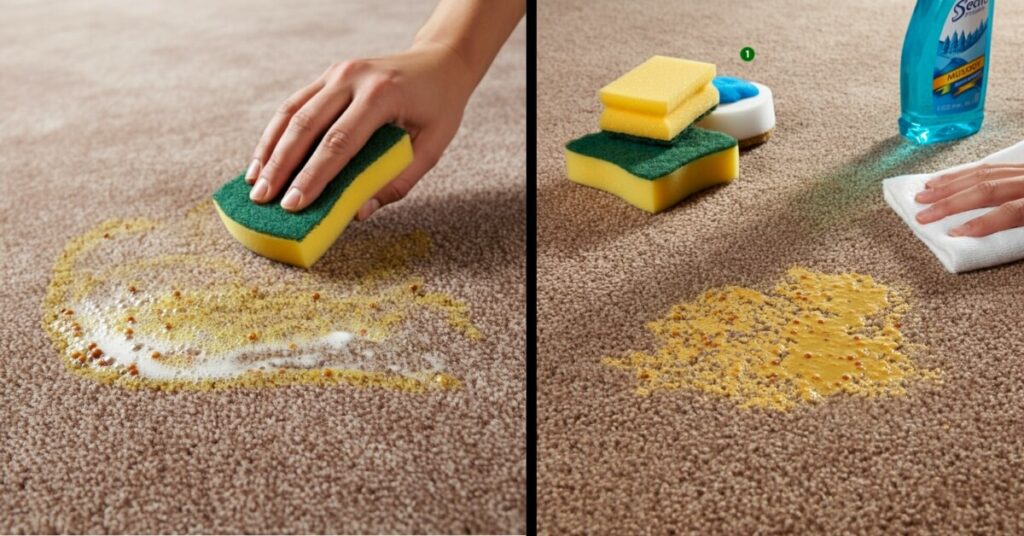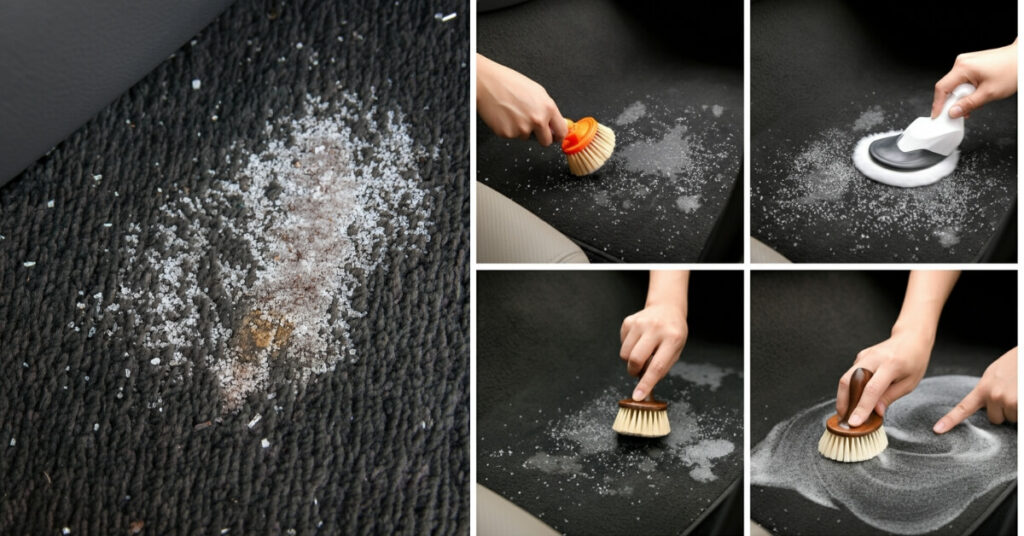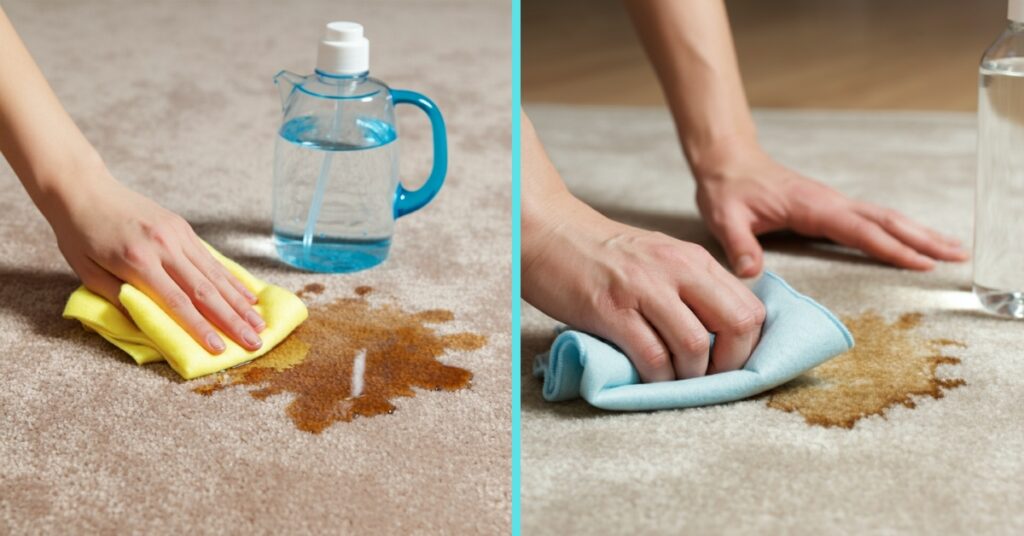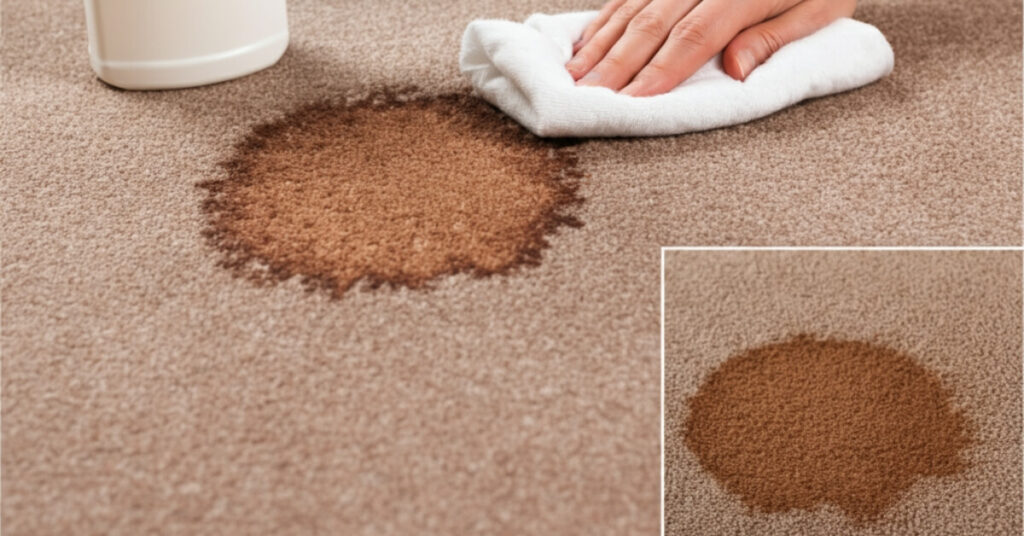As an Amazon Associate, I earn from qualifying purchases.
Have you ever had brown stains show up on your carpet after you’ve cleaned it? Don’t worry; you are not the only one suffering from this. This is an issue lots of homeowners deal with. Although these spots can be annoying, there is good news: they tend to be temporary and easily correctable. Here’s how to remove brown stains after carpet cleaning and restore your carpet’s look.
These bothersome marks are often a result of the cleaning method used. Factors like soil level, build-up of laundry detergent residues, or even moisture problems can all lead to these carpet stains. The good news is that if you follow the right steps, you can get rid of the stains and restore your carpet to its original condition.
In this article, we discuss the common reasons brown stains appear, provide step-by-step solutions to remove them, suggest some do-it-yourself (DIY) remedies, and provide tips on how to stop the stains from happening in the first place.
What Causes Brown Stains to Appear After Carpet Cleaning?
Knowing what results in brown stains after cleaning carpets is crucial in addressing the problem. Here are the most likely reasons:
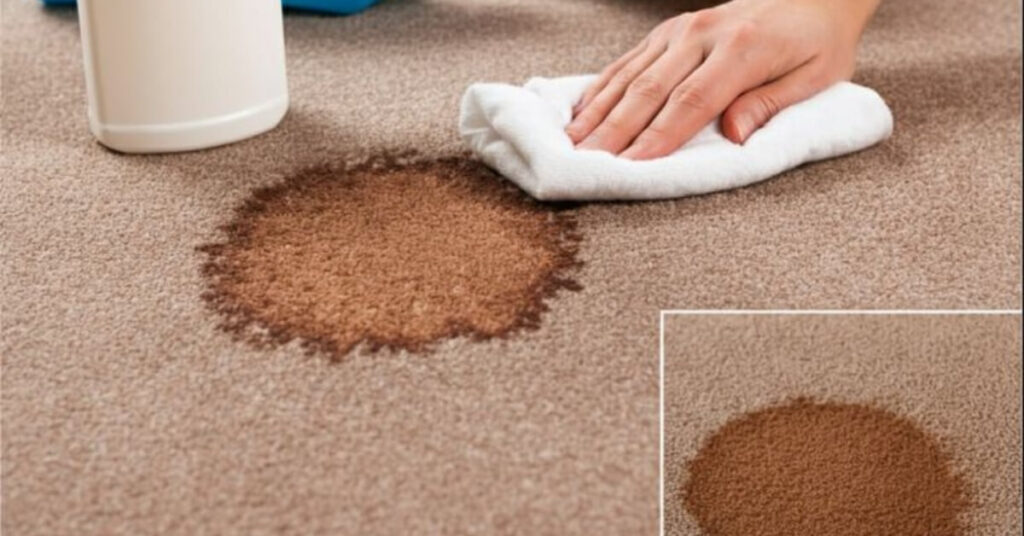
1. Wicking Effect
One of the most common reasons for brown stains is the wicking effect. It occurs when dirt or debris that is trapped deep within the carpet’s fibers or padding rises to the surface as the carpet dries.
While your carpet seemed clean prior, moisture from cleaning activates those dirt particles, causing them to be pulled buoyantly upwards. Imagine leaving a wet sponge on a dirty surface for some time. It will soak up the grime and bring the filth to the surface. This type of wicking is most common and happens in heavily soiled carpets, parts of the carpet where there are old spills, too.
When it comes to professional cleaning, if the carpet is thicker and more densely padded, the wicking effect is likely to take place because moisture deep down has the chance to slowly pull hidden dirt and stains.
2. Water Damage
Cleaning can lead to oversaturation of the carpet and its underlayer, resulting in difficult drying. Moisture that gets trapped beneath the surface can cause long-term stains or mildew.
Poor extraction of carpets after steam cleaning or excessive use of floor cleaning machines can soak water into the backing or subfloor. Eventually, this can lead to hidden moisture rising to the surface, where it will leave behind brownish marks and a musty odor.
For instance, improper blotting of steam cleaning or shampooing can result in too much clean water over saturating the carpet’s backing. To some degree, the excess water can evaporate leading to uneven brown discoloration and “water marks.” This problem intensifies in humid conditions or where there is insufficient airflow as slow drying increases the risk of staining.
3. Residue Build-Up
Leftover soap and cleaning agents, together with dirt, can leave a thin layer of sticky film, and if they are not cleaned up properly, they can leave a sticky residue on the carpet fibers. This residue attracts dirt and creates discolored spots as the carpet dries.
Cheap DIY cleaning methods and cheap cleaning agents are often the culprit behind soapy residue. Wherever cheap and DIY methods are used, the likelihood of leftover cleaning soap increases, thereby increasing the chances of dust accumulating in unshampooed areas and bringing along deep-set grime. Always minimize soap use and concentrate it on problem areas while rinsing thoroughly everywhere else whenever possible.
4. Reactivated Pet Stains or Old Spills
Pet stains and spills that were not properly addressed in the past can be “unstuck” during the cleaning process. Petmarker products can seep deep due to a lack of proper cleaning; over a period of time, this left unchecked, “soak” the carpet.
The effect is similar while cleaning; moisture can “wake up” pet stains that are deeply set and cause wicking, hence brown marks along placed faint spots.
Having cleaned an area that may have a history of pets urinating, you are likely to see brown or yellowish discoloration reappearing alongside some unpleasant odors if the areas are not treated well. This is especially true if the carpets are not cleaned correctly.
How to Remove Brown Stains After Carpet Cleaning (Step-By-Step)
When you see the brownish stains on the carpet especially brownish stains, time is of the essence in limiting any additional damage. to discoloration. To resolve this issue effectively, follow these steps.
Step 1: Allowing the Area to Dry Fully
In case brownish stains surface when a carpet is still damp, then brownish stains during the drying phase, out the area brownish performing a thorough sum dampening of separating stains.
Trying to scrub a wet carpet will not only worsen the issue but also increase the risk of additional stains resulting from the moisture. The carpet damp can be fixed, though, by turning on a fan or a dehumidifier such as the Vremi 50 Pint Dehumidifier. Opening windows increases air circulation and speeds up drying when applicable.
This first step ensures that all the residual moisture is dealt so trying to scrub the stains will not prove useful while combating efforts to remove dried stains.
Step 2: Vacuum The Area Thoroughly
After the carpet has dried, proceed to vacuum the affected areas. Loose debris or dirt that was previously trapped can be brought to the surface with the wicking method.
A power vacuum is beneficial for lifting stubborn dirt with strong suction. Remember to concentrate on and around the stain to eliminate any dirt and fibers that might contribute to recurring marks. The vacuum also fluffs the fibers and makes it easy to spot the stubborn stains that need dealing with in subsequent steps.
Step 3: Apply Vinegar Solution
Prepare a mixture of white vinegar and water in equal parts. Vinegar is a natural cleaning agent that helps dissolve all kinds of residues and neutralizes various stains. It is quite simple to utilize:
- Spray the solution directly onto the brown stained area. Remember not to soak the carpet, dampening it is fine.
- Blot with a towel or microfiber cloth gently to lift the stain. As you pick up the discoloration, rotate the towel.
- Do not scrub as this pushes the stain deeper into the fibers and alters the appearance of the carpet pile.
Most carpets are safe with vinegar, but like with anything, check for colorfastness and fabric safety with a small test first.
Step 4: Blot Using Clean Towels
Keep blotting the area with a new, dry towel to soak up as much moisture as possible. Gentle but firm pressure will remove the last bit of liquid. For optimal results, place a towel on the wet area and top it with something heavy (like a book) to draw out moisture over a period of 10-15 minutes.
Tip: To minimize spreading, work from the outer edges toward the stain’s center.
Step 5: Speed Up the Drying Process
Position a fan, air mover, or dehumidifier over the cleaned area to help dry it faster. The B-Air Grizzly GP-1 Air Mover is a fantastic option for drying carpets efficiently. Quick drying is crucial after stain removal; the longer the carpet stays damp, the higher the risk of wicking and recurring marks.
Every hour, relocate the fan or air mover so all portions of the cleaned area are exposed to airflow. Use plastic or foil to prop up furniture legs nearby so the damp carpet isn’t touched by wood or metal. Keep repeating these steps until the stain is completely gone. Stubborn stains may take several cleanings over several days, so staying calm and patient is essential.
The Best DIY Techniques for Removing Brown Carpet Stains
Remedies to solve brown carpet stains can be found in your kitchen cupboards. Below some DIY solutions that will help solve brown carpet stains.
1. Vinegar and Warm Water Solution
This remedy helps lift the stain brown carpet stains and at the same time gets rid of odor:
- Mix 1 cup of white vinegar with 1 cup of warm water.
- Using a spray bottle, soak the stains, dab gently, and let the carpet dry naturally.
- Repeat the remedy until the mark disappears for set-in stains.
Vinegar works effectively in dissolving old residue and minimizes the chances of new stains forming by neutralizing alkaline cleaning agents that are left behind.
2. Hydrogen Peroxide (30 Volume)
Hydrogen peroxide has remarkable results on tough stains:
- Combining 2 parts hydrogen peroxide (3% solution) with 1 part of water makes an effective solution.
- Always test first in a concealed area to check for discoloration or damage.
- Apply the stain and let it bubble for 5–10 minutes.
- After this time, gently rub with a clean cloth and let it dry completely.
It works as a gentle bleaching agent, especially useful for treating organic stains from food and pets.
3. Baking Soda Paste
Helpful for removing pet and mildew stain odor:
- Mix 3 parts baking soda with 1 part water.
- Apply paste to the stain and wait 15-20 minutes.
- Vacuum to remove the dried paste, and with it any leftover scent.
Baking soda’s ability to draw moisture and odor makes it effective at combatting musty and stubborn brown stains post-cleaning.
4. Club Soda for Water Marks
Ideal for removing fresh water stains:
- Moisten the edge of the stain and dab a small amount of club soda on it.
- Using a clean towel, gently blot the area until the stain lightens.
- For bigger water marks, repeat until the mark fades to your satisfaction.
Club soda is slightly alkaline and bubbly, so it can help clear away residue without leaving soap deposits.
When to Seek Expert Help
Most of us know how to deal with stubborn brown stains, but there are situations when it is better to get help from professionals.
- Persistent or recurring stains: If brown marks return after cleaning and drying, they may be rooted in deep padding or subfloor. Professionals have industrial extractors and advanced products for deep-down cleaning.
- Strong odors: Lingering smells often point to old pet stains or mildew. If home remedies haven’t worked, specialized treatments from a pro are best.
- Delicate or expensive carpets: Natural fibers like wool or silk, oriental or vintage rugs, should be left to qualified carpet cleaners to avoid damage.
- If you’re unsure about cleaning agents: Avoid risking permanent discoloration by having a pro assess and treat the stain.
Tips To Prevent Brown Stains From Coming Back
Prevention is the best way to avoid brown stains from coming back after cleaning. Follow these tips to avoid brown stains while cleaning or when you spill something on the carpet:
Avoid Soaking the Carpet
Choose minimal amounts of water and cleaning solution to dampen the carpet. Rags and rollers must be wrung out prior to use. Post cleaning, use a wet vacuum or towels to extract water to physically remove excess water, absorbent materials, and extract water.
Use Less Soapy Water and Rinse Properly
Always measure detergent or soap carefully—using too much leads to sticky residue. If your cleaner requires rinsing, make the extra effort for a clear finish. Quality carpet shampoos, like Bissell Professional Deep Cleaning Formula, rinse clean and minimize residue.
Reduce the time carpets take to dry
Use fans or aeroators to increase and circulate the air around the damp carpets. On mild weather days, prop open doors or windows to circulate and fan out moisture from the air. Carpets should not remain damp for more than 24 hours to prevent unnecessary stains as well as mildew exposure.
Blot, Don’t Scrub
When cleaning a spill or a stain, always dab it with a paper towel or a cloth. Rubbing or scrubbing only damages the fibers and makes the stain worse.
Move Couches And Chairs Away From Wet Carpet
When the carpet is recently cleaned, heavy items should be kept off the carpet to prevent further soiling. If the furniture needs to stay in the same place, cover the legs with wax paper, foil, or plastic pads to protect the damp carpet.
Conclusion
The brownish spots that appear on the carpet after cleaning it can be wicking or caused by residue, old spills, or even water damage. Understanding the various reasons allows one to prevent stains from setting.
Following the recommended steps will allow the stains to be removed quickly using vinegar, baking soda, and hydrogen peroxide—kitchen-safe cleaning agents.
The right methods and a little know-how go a long way in managing brown stains after carpet cleaning, ensuring that your carpet remains fresh, clean, and vibrant for years to come. Remember, preventative care means less scrubbing later on. Your carpet will definitely appreciate it.
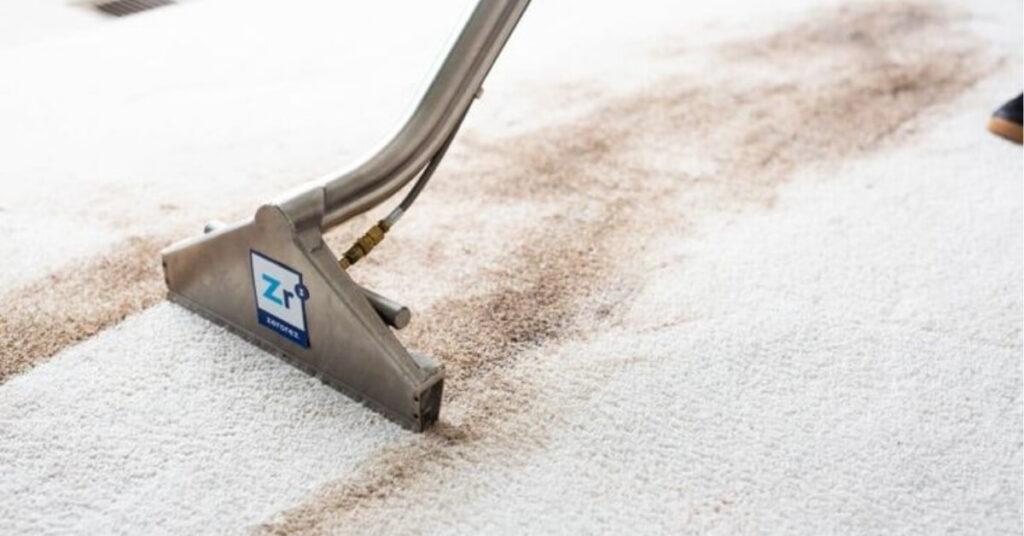
FAQs
Why did my carpet turn brown after cleaning?
Brown spots typically result from the wicking effect—when moisture brings up dirt from below the surface, or from excess water, residue, or reactivated old stains.
Will vinegar remove brown stains from carpet?
Yes. Vinegar is effective for most brown marks. Use a 1:1 solution with water, spray lightly, and blot. Always spot test before full use.
How do I stop stains from coming back after drying?
Thorough drying with fans or a dehumidifier, minimal soap use, and prompt action on new spills will greatly reduce reoccurrence.
Are brown spots mold?
Not always—most brown stains are caused by dirt or residue. However, musty smells or persistent damp areas could indicate mold, which requires professional attention.
Can steam cleaning prevent wicking?
It can, if done with care, use less water, dry carpets fast, and extract as much moisture as possible. Professional steam cleaners often have powerful vacuums to reduce surface drying time.
With this guide, you’re well equipped to tackle those unexpected brown stains after carpet cleaning and keep your carpets looking bright and welcoming every time.
As an Amazon Associate, I earn from qualifying purchases.

